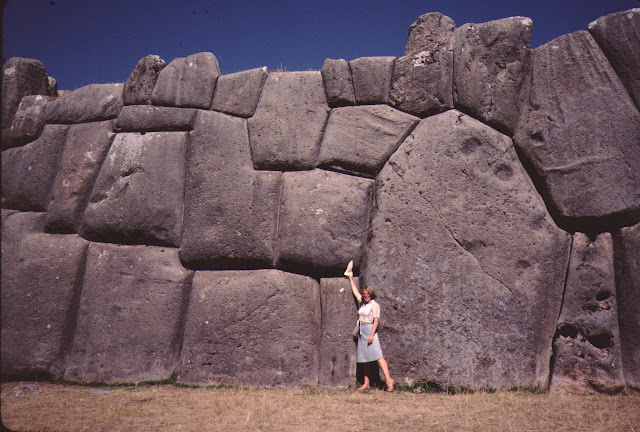Cuzco, Peru May 25-29, 1979
Well that was exciting! Having discovered that the bus ride from Ayachucho to Cuzco was well over 12 hours, on perilous mountain roads, in questionable buses, Sue and I decided to fly. The flight was apparently pretty good, in terms of safety, and took just over 3 hours. We booked a flight for the morning of May 24th, and got to the little Ayachucho airport on time, only to be told that the plane was ‘roto’ (broken), and we should come back at the same time the next day, when it would be ready (ie. not broken). As we left we peered through a wire mesh fence and could see the old prop plane on the tarmac with several workers scurrying around. We could hear the sound of banging and clanging. Presumably they were fixing whatever was ‘broken’. I shuddered to think. Anyway we arrived the next day and were told the plane was ‘fixed’ and ready to go. So on we got and up we went. Despite the anxiety I felt flying in this small, old, prop plane over some of the highest mountains in the world, I did manage to enjoy the spectacular views of the Andes. And we did land in Cuzco safely. Gracias a dios.
Cuzco, either from the air or from the Citadel Sacsayhuaman
Having gotten here I find I am experiencing a bit of culture shock. Cuzco feels like a Peruvian Panajachel – it’s a very busy, touristy town with all kinds of gringos – from the well-healed, elite, and mostly package, tourists to the scraggly ‘do-it-yourself’ back-packers traveling the ‘gringo trail’.
When we arrived at the airport we chatted with members of an American team of river-runners, park wardens, psychologists and photographers who are whirl-winding their way through the archaeological wonders of Peru. They’ll be staying in top hotels and taking the train to Machu Picchu. They’ll mostly be dealing with the sparkling, animated, culturally and socially elite group of young Cuzco-ites. Like the ones who sell exquisite old weavings, ceramics, carvings, masks and beads – from out of the manager’s suite of the Tourist Hotel. Another group of tourists sporting Lake Titicaca shirts, were bleary-eyed and runny-nosed from too much cocaine. For some it’s a frenzied and fast-paced party scene here – so different from the way in which I’ve been traveling, and the realities I’ve been living. And in the midst of it, of course, the ever-present indios – vendadores and mendicants – wandering the streets, trying to take advantage of all of these tourists with money to spend.
Cuzco was the centre of the Incan Empire. The Quechua word ‘Cuzco’ means naval. It is a beautiful old, colonial town with winding cobble-stone streets and stair-streets, somewhat like a cross between old-city Jerusalem and Dubrovnik. Everywhere there is evidence of Incan times – monolithic stone walls, their massive, massive rocks chiseled and sculpted to fit together perfectly, absolutely perfectly, with no mortar or ‘glue’ to hold them in place. Some of the stones weigh as much as 30 tons. No one knows how they were first quarried and carved, and then transported and hoisted into position. Without metal implements, without the wheel. Interestingly, these giant stone mosaics, in some places 20-30 feet high, don’t feel forbidding or menacing – their warm grey colour makes them feel somehow softer, more protective, almost welcoming. These monolithic walls, or the ruins of them, are everywhere.
From a postcard, one of the many walled streets of Cuzco
We puffed and panted our way up to the Citadel of Sacsayhuaman. Built by the Inca in the 15th Century, the rockwork here is truly awe-inspiring. According to Wikipedia:
The best-known zone of Sacsayhuamán includes its great plaza and its adjacent three massive terrace walls. The stones used in the construction of these terraces are among the largest used in any building in pre-Hispanic America. They display a precision of cutting and fitting that is unmatched in the Americas.[14] The stones are so closely spaced that a single piece of paper will not fit between many of the stones. This precision, combined with the rounded corners of the blocks, the variety of their interlocking shapes, and the way the walls lean inward, is thought to have helped the ruins survive devastating earthquakes in Cuzco. The longest of the three walls is about 400 meters. They are about 6 meters tall. The estimated volume of stone is over 6,000 cubic meters. Estimates for the weight of the largest andesite block vary from 128 tonnes to almost 200 tonnes.
For more information about Sacsayhuaman go to: https://en.wikipedia.org/wiki/Sacsayhuamán
Sacsayhuaman doorway
Here in Cuzco, despite the distractions of rampant tourism, I can feel the power, the mountain magic and mystery. Here in this ‘navel’ the forces of the cosmos are pulled in and concentrated. The sun feels stronger; the light brighter; the flowers more profuse, more brilliant, more full of life; the people are more ‘energized’, more magic. This is a very special place, a very strong place. In a few days we will leave, first to visit Ollantaytambo, a ruin about half-way between here and Machu Picchu, where we plan to relax, re-align, and centre ourselves before heading to the most powerful centre – Machu Picchu.
On the streets of Cuzco, this lovely woman agreed to pose for me with her llama
















Comments
Post a Comment